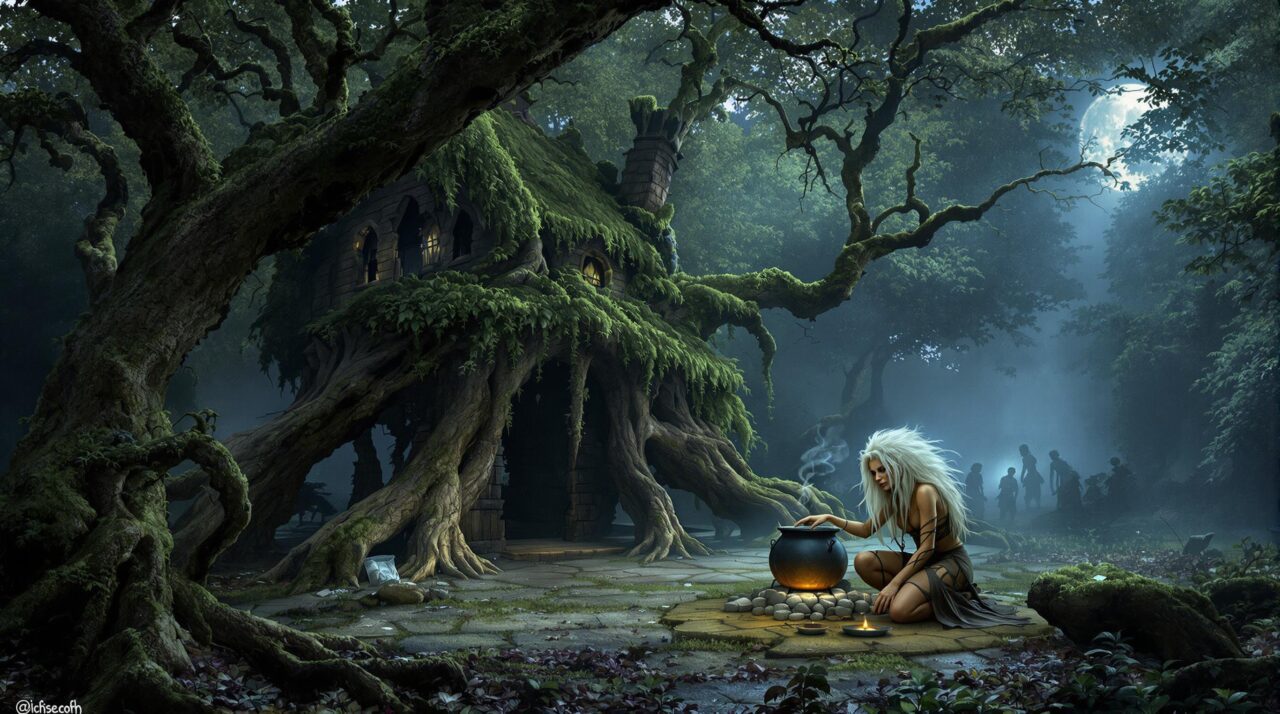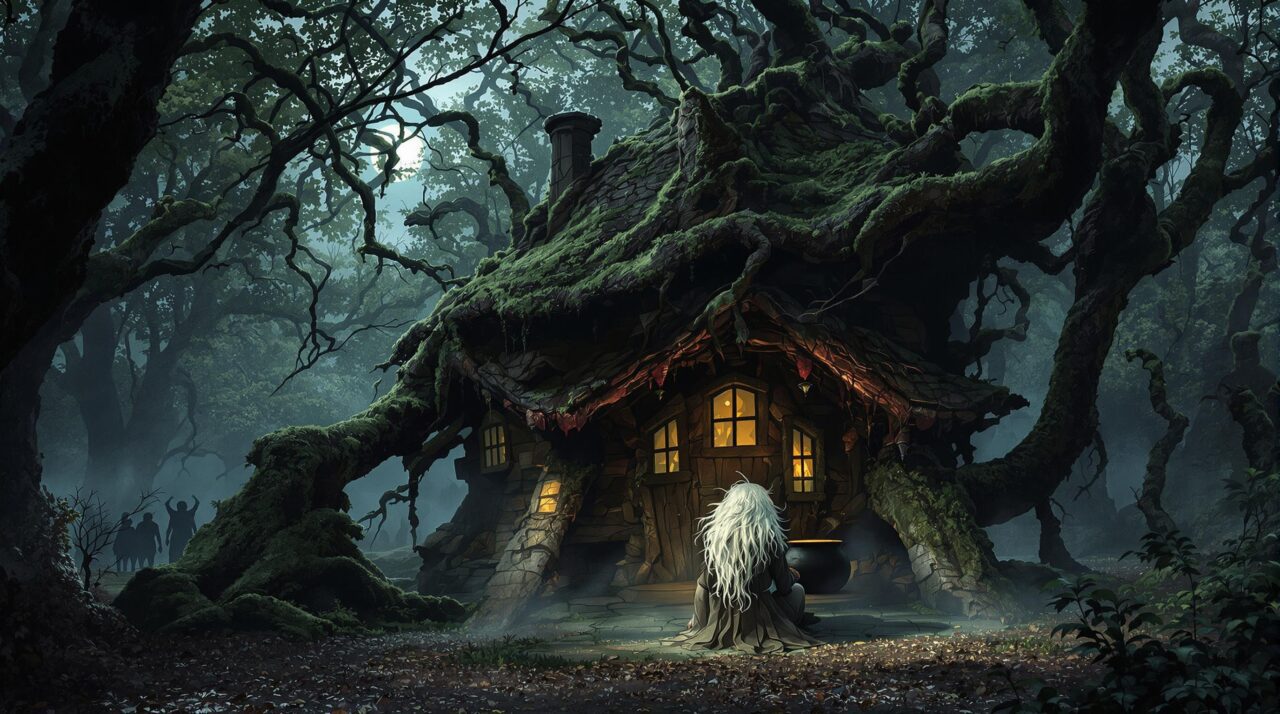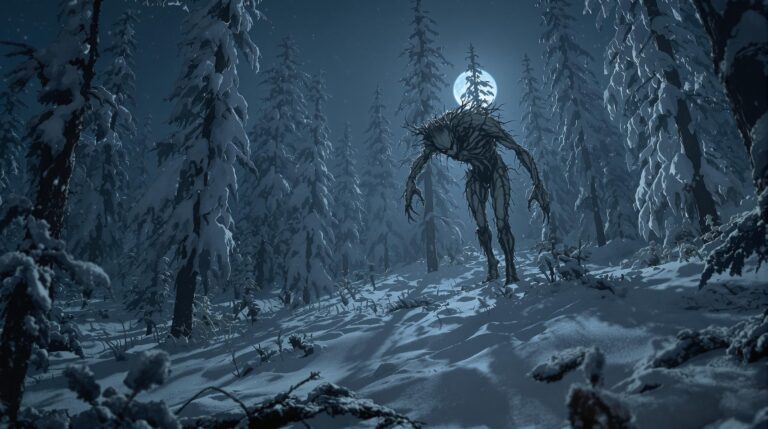Baba Yaga: Slavic Witch of the Woods

Baba Yaga, a figure steeped in Slavic folklore, serves as a complex representation of femininity and power.
Her hut, uniquely perched on chicken legs, raises questions about the boundaries between the ordinary and the extraordinary.
Encounters with her often present formidable challenges, yet they also offer profound insights into human nature.
As these narratives evolve, they invite exploration into why Baba Yaga continues to capture the imagination and what her legacy reveals about contemporary society.
Principal Conclusions
Hide- Baba Yaga originates from Eastern European folklore, representing complex themes of femininity, power, and the duality of human nature.
- Her iconic hut, supported by chicken legs, symbolizes the intersection of the mundane and magical, embodying unpredictability and transformation.
- Encounters with Baba Yaga often present moral lessons, emphasizing the importance of cleverness and the consequences of one's choices.
- Modern interpretations of Baba Yaga have evolved, portraying her as both a malevolent figure and a symbol of empowerment and feminist ideals.
- Baba Yaga's enduring legacy transcends cultural boundaries, inspiring contemporary art, literature, and media while challenging traditional narratives.
The Mythical Roots of Baba Yaga

The origins of Baba Yaga in Eastern European folklore present a vibrant mosaic of cultural beliefs and mythological influences.
As her name and image have evolved over centuries, they reflect the shifting perceptions of feminine power and the complexities of nature in Slavic societies.
Analyzing these transformations offers valuable insights into the broader themes of fear, respect, and the duality of the witch archetype.
The Mysterious Origins in Eastern Europe
The origins of Baba Yaga are shrouded in mystery, drawing connections to ancient Slavic traditions that reflect the complexities of nature and femininity.
Comparative analysis with other folkloric witches reveals striking similarities, suggesting a shared cultural heritage that transcends geographical boundaries.
This exploration invites a reconsideration of Baba Yaga not just as a solitary figure, but as a representation of deeper mythical narratives prevalent in Eastern European folklore.
Possible Links to Ancient Traditions
While exploring the enigmatic figure of Baba Yaga, one cannot help but consider her possible connections to ancient Slavic traditions and pre-Christian beliefs.
Scholars suggest that her character embodies the duality of nature, reflecting both nurturing and destructive elements. This complexity may reveal insights into early Slavic spirituality, where the sacred and the profane coexisted, illustrating humanity’s relationship with the untamed wilderness.
Comparisons with Other Folklore Witches
Baba Yaga’s multifaceted persona invites intriguing comparisons with other folklore witches across various cultures, revealing a shared archetype that transcends geographical boundaries.
Similar to the cunning witches of Western European tales, such as the cunning Morgan le Fay, Baba Yaga embodies both nurturing and malevolent traits, reflecting societal fears and desires.
This duality highlights the universal nature of witch archetypes throughout world folklore.
Evolution of Her Name and Image
The name and image of Baba Yaga have undergone significant transformation throughout the centuries, reflecting the diverse cultural narratives of Eastern Europe.
Regional variations in her stories illustrate how different communities have adapted her character to embody their unique values and fears.
Additionally, the evolution of her depictions over time reveals shifting societal attitudes towards femininity, power, and the supernatural.
Variations in Regional Stories
As the tale of Baba Yaga weaves through the diverse tapestry of Slavic folklore, it becomes evident that her image and name have evolved markedly across various regions.
In some narratives, she emerges as a malevolent force, while in others, she embodies wisdom or serves as a guardian of nature.
These variations reflect cultural values and historical contexts, illustrating the complexity of her enduring legend.
Depictions Through Different Time Periods
While the essence of Baba Yaga has remained a fascinating subject within Slavic folklore, her depictions have transformed considerably over the centuries, reflecting changing societal norms and beliefs.
Initially portrayed as a fearsome crone, she evolved into a complex figure embodying both wisdom and malice.
These shifts reveal the dynamic interplay between cultural identity and the archetypal roles women inhabit within folklore throughout history.
Baba Yaga’s Iconic Hut and Its Oddities
Baba Yaga’s hut, famously supported by chicken legs, serves as a striking symbol of her enigmatic nature and the peculiarities of Slavic folklore.
This otherworldly dwelling not only illustrates the intersection of the mundane and the magical but also invites contemplation on the broader themes of transformation and mobility within myth.
In this way, the hut becomes a character in its own right, embodying the contradictions and complexities of the witch herself.
The Chicken-Legged Hut
The Chicken-Legged Hut serves as a compelling symbol of Baba Yaga’s unpredictable nature and her role within Slavic folklore.
Its ability to move and reposition itself reflects themes of protection, evasion, and the fluid boundaries between safety and danger.
Moreover, the hut’s unique guardian elements and protective spells invite exploration into how folklore intertwines with cultural values and the human psyche.
Symbolic Meanings of the Hut’s Movement
Movement is a powerful symbol in folklore, and in the case of Baba Yaga’s iconic chicken-legged hut, it embodies the unpredictable nature of the witch herself.
This erratic locomotion reflects the duality of chaos and control, suggesting that freedom often comes at the cost of instability.
The hut’s dance through the forest also represents the fluidity of power in a world governed by ancient magic.
Protective Spells and Guardian Elements
Although often perceived as a mere dwelling, Baba Yaga’s chicken-legged hut serves a deeper purpose as a protective entity, embodying the essence of guardian elements in Slavic folklore.
Its unique ability to relocate symbolizes adaptability and vigilance, safeguarding against malevolent forces.
This living structure not only reflects the harmony between nature and magic but also represents the continuous search for protection in a chaotic world.
Otherworldly Forest Dwelling
Baba Yaga’s hut, marked by its eerie threshold and the chilling fence of skulls, serves as a profound symbol of the liminal space between life and death.
This unsettling entrance not only signifies a boundary to her otherworldly domain but also encapsulates themes of transformation and the cyclical nature of existence.
The juxtaposition of life and mortality within this forest dwelling invites reflection on the deeper meanings embedded in Slavic folklore.
Significance of the Threshold and Fence of Skulls
The threshold and fence of skulls surrounding Baba Yaga’s iconic hut serve as profound symbols of the boundary between the known and the unknown, reflecting the witch’s role as both protector and predator in Slavic folklore.
This unsettling imagery invites contemplation on the duality of nature and the human experience, challenging visitors to confront their fears while traversing the liminal space between safety and danger.
Ties to Life, Death, and Transformation
Nestled deep within the enchanted forests of Slavic folklore, Baba Yaga’s hut stands as a potent emblem of the intricate interplay between life, death, and transformation.
Its peculiarities reflect the dualities of existence:
- A chicken-legged foundation, symbolizing instability.
- Windows that reveal hidden truths.
- An entrance that shifts with intention.
- The ability to vanish, representing life’s impermanence.
Such oddities provoke contemplation on the cycles of nature.
Folklore Tales: Encounters with Baba Yaga
Baba Yaga’s encounters in folklore often reveal a dual nature, serving as both a source of wisdom and a formidable obstacle.
In numerous Russian and Eastern European tales, characters find themselves at the mercy of her unpredictable whims, where guidance may be nestled within her challenges.
This complex relationship not only illustrates her role as a powerful figure in Slavic mythology but also raises questions about the nature of encounters with the unknown.
Acts of Guidance and Challenges
In the folklore surrounding Baba Yaga, encounters often serve as critical tests of character and courage.
Those who seek her guidance must navigate a labyrinth of challenges, where success yields valuable rewards, while failure can lead to dire consequences.
This duality not only reflects the complexities of human nature but also emphasizes the moral lessons inherent in these tales.
Tests of Character and Courage
Encounters with Baba Yaga often serve as pivotal tests of character and courage for those who dare to seek her out.
These challenges reveal the essence of one’s spirit through:
- Confronting fears in the enchanted forest.
- Solving riddles that demand wisdom.
- Displaying compassion towards the vulnerable.
- Demonstrating resilience against overwhelming odds.
Such trials illuminate the path to self-discovery and personal growth.
Rewards for Passing or Penalties for Failure
While facing the formidable trials set forth by the enigmatic witch, those who succeed often find themselves rewarded with more than mere survival; they gain invaluable gifts that reflect their inner strength and wisdom.
Conversely, failure leads to dire consequences, revealing the harsh reality of Baba Yaga’s world.
Each encounter serves as a profound lesson, illuminating the balance between ambition and consequence.
Appearances in Russian and Eastern European Stories
Baba Yaga’s appearances in Russian and Eastern European folklore reveal a tapestry of common themes that highlight the complexities of human experience.
Often serving as both a fearsome antagonist and a source of wisdom, her character embodies cultural lessons that challenge societal norms and personal growth.
These narratives, while steeped in the supernatural, ultimately reflect the moral and ethical dilemmas faced by individuals within their communities.
Common Themes in Baba Yaga Legends
Common themes emerge throughout the diverse encounters with Baba Yaga in Slavic folklore, showcasing her multifaceted nature as both a benevolent and malevolent figure.
These tales often explore:
- The duality of nature—creation and destruction.
- The importance of cleverness and resourcefulness.
- The journey of self-discovery and transformation.
- The balance between fear and respect for the unknown.
These elements enrich the cultural tapestry surrounding Baba Yaga.
Cultural Lessons Hidden in Scary Narratives
Folklore often serves as a mirror reflecting societal values, fears, and aspirations, and the tales of Baba Yaga are no exception.
These narratives expose deep-seated anxieties surrounding femininity, power, and the unknown. Through encounters with Baba Yaga, characters confront their limitations and societal expectations, revealing profound lessons about resilience, choice, and the complexity of human nature amid the shadows of cultural fears.
Symbolic Role and Cultural Influence
Baba Yaga embodies the complex interplay between civilization and the untamed wilderness, serving as a guardian of the boundary between these two domains.
Her character reflects the dangers and unpredictable nature of the wild, symbolizing the fears and challenges that lie beyond the safety of human society.
Through her multifaceted persona, Baba Yaga influences cultural narratives, shaping perceptions of nature and the unknown in Slavic folklore.
Guardian of the Boundary Between Worlds
Baba Yaga embodies the duality of nature’s forces, serving as a potent symbol of the intricate balance between life and death.
Her magic reflects both the nurturing and destructive aspects of the natural world, illustrating the complex relationship humans have with their environment.
As a guardian of the boundary between domains, she challenges individuals to confront their fears and embrace the unknown, thereby influencing cultural narratives surrounding transformation and growth.
Nature’s Forces Represented by Her Magic
While often depicted as a fearsome witch, the character embodies a complex interplay of nature’s forces through her magic, reflecting the duality of creation and destruction.
Her essence symbolizes the following:
- Fertility – Nurturing life in the forest.
- Chaos – Unpredictable, tempestuous nature.
- Transformation – Shifting forms and identities.
- Protection – Safeguarding sacred boundaries.
These elements highlight her role as a guardian of nature’s intricate balance.
The Balance Between Life and Death
How does the figure of Baba Yaga encapsulate the delicate balance between life and death in Slavic folklore?
As a guardian of thresholds, she embodies transformation, traversing the liminal space between existence and oblivion.
Her duality invites both reverence and fear, emphasizing the interconnectedness of creation and destruction.
This complexity reflects cultural beliefs, shaping perceptions of mortality and the cyclical nature of life.
Metaphor for the Wilderness and Its Dangers
Baba Yaga serves as a potent metaphor for the wilderness, embodying both its allure and its perils.
Her character teaches respect for the unknown, illustrating how fear and awe can coexist in the face of nature’s unpredictability.
This duality reflects a cultural understanding that the wilderness is not merely a backdrop, but a formidable force that demands reverence and caution.
Lessons on Respecting the Unknown
What lessons can be gleaned from the figure of Baba Yaga, the enigmatic Slavic witch, when it comes to the wilderness and its inherent dangers?
Her story serves as a cautionary tale, emphasizing the need to respect the unknown.
Key lessons include:
- Acknowledge unpredictability.
- Understand nature’s power.
- Embrace humility in exploration.
- Recognize the duality of fear and respect.
Blending Fear with Awe
Drawing from the intricate fabric of Slavic folklore, Baba Yaga embodies a complex interplay between fear and awe, serving as a potent symbol of the wilderness and its myriad dangers.
Her unpredictable nature reflects humanity’s relationship with nature—both enchanting and treacherous. In this duality, she invites contemplation on respect for the unknown, highlighting the wilderness as a space of both peril and profound beauty.
Modern Takes and Lasting Popularity
Baba Yaga’s presence in contemporary literature and film highlights her adaptability and enduring appeal as a cultural icon.
Her character serves as a lens through which diverse themes—such as empowerment, fear, and the complexity of femininity—are explored, resonating with audiences across various cultures.
This ongoing fascination underscores her significance not only within Slavic folklore but also in the broader narrative of global mythology.
Baba Yaga in Literature and Film
Baba Yaga’s presence in contemporary literature and film reflects a fascinating evolution of her character, showcasing her adaptability to modern narratives.
Recent portrayals often reimagine the Slavic witch, transforming her from a malevolent figure into a complex symbol of empowerment and resilience.
This shift not only highlights her lasting popularity but also invites audiences to reconsider traditional archetypes and their relevance in today’s cultural landscape.
Notable Portrayals in Contemporary Media
How has Baba Yaga’s enigmatic persona evolved in contemporary media? This mythical figure has intrigued audiences through various modern interpretations, revealing her multifaceted nature.
Notable portrayals include:
- “The Witcher” series – A blend of folklore and fantasy.
- “Kubo and the Two Strings” – A reimagined interpretation.
- “Vasilisa the Beautiful” – A literary retelling.
- Graphic novels – Illustrated adaptations exploring her legacy.
These adaptations underscore her lasting allure.
Reimagined Versions for Modern Audiences
While the essence of Baba Yaga remains rooted in Slavic folklore, her reimagined versions for modern audiences reveal a complex interplay of tradition and contemporary themes.
These reinterpretations often explore feminism, power dynamics, and environmental concerns, casting Baba Yaga as both a villain and a powerful ally.
Such narratives invite reflection, challenging viewers to reconsider societal norms while embracing the witch’s enduring allure.
Ongoing Fascination Across Cultures
Baba Yaga’s enduring presence in various forms of art, comics, and video games underscores her status as a cultural icon that transcends her Slavic roots.
This multifaceted witch not only captivates contemporary audiences but also influences modern storytelling by challenging traditional narratives and archetypes.
As she evolves through diverse mediums, Baba Yaga continues to reflect and reshape the complexities of fear, power, and femininity in today’s society.
Appearances in Art, Comics, and Video Games
Numerous adaptations of Baba Yaga in contemporary art, comics, and video games reveal the enduring allure of this Slavic witch within global culture.
Her multifaceted character continues to resonate, inspiring creators with her complex nature.
Key representations include:
- Artworks exploring her mystical symbolism.
- Graphic novels depicting her as a powerful figure.
- Video games featuring her as a formidable antagonist.
- Animated films reimagining her in modern contexts.
Influence on Contemporary Storytelling
As contemporary storytellers draw from a lively array of global folklore, the figure of Baba Yaga emerges as a compelling archetype that transcends cultural boundaries.
Her duality as both benevolent and malevolent captures the complexities of human nature, inviting reinterpretation in literature, film, and art.
This ongoing fascination reflects a universal quest for understanding the unknown, fostering dialogue across diverse cultural narratives.
Wrapping Up
In the tapestry of folklore, Baba Yaga emerges as both a harbinger and guardian of transformation. Her hut, a threshold between worlds, invites seekers to confront their fears and desires. As the embodiment of the wild feminine, she challenges societal norms, urging introspection and courage. Ultimately, Baba Yaga serves as an allegory for the journey of self-discovery, reminding us that within the shadows of the forest of life lie profound truths waiting to be revealed.
